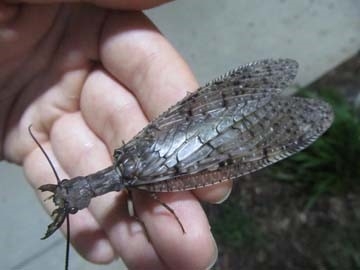This week's insect is a fairly impressive predator. Dobsonflies are aquatic insects in the family Corydalidae, order Neuroptera - same order that includes Green and Brown Lacewings, Ant Lions, and Snake Flies. Only the larval stage is aquatic, but it may last several years. The larvae are known as “hellgrammites”, and are also very impressive predators, often catching and feeding on small fish. This is something that you don't see too often, a lower form of animal life, an insect, predating on a higher form, a fish. You do see it once in a while though. I have seen large tropical tarantulas kill and eat young birds in the nest. I had a person tell me they had seen a large Chinese mantid catch and try to eat a hummingbird, but the bird died after being caught and the mantid dropped it.
As you can see from the picture it is a large insect, some of the largest being nearly 5 inches in length. Adults are highly attracted to lights at night. The males have the very impressive large mandibles, but these are not meant to bite humans. They are most likely used on other male dobsonflies, to pick them up and throw them off to the side when competing for a female's attention. Mandibles this large are seldom functional for anything else, and you can feel a strong poke when they try to bite but it seldom breaks the skin. Now the females are a different story. Their mandibles are very functional. While trying to pick some females off our backlight sheet on a tropical collecting trip, I had to be very careful to grab them close to their head. Grab them closer to their body, and they can turn their head and bite. It does hurt and it drew blood.
The female's highly functional mandibles indicate that it probably is a predator as an adult. I'm not sure what they would eat, but anything smaller than it is, would probably be fair game. I don't believe the males predate as adults. Dobsonflies do occur in California, especially in rivers and streams coming down through the Sierra Nevada foothills. But the local males don't have mandibles quite as large as those from the tropics.
This will be my last article for two weeks. I am leaving the country for a tropical collecting trip to French Guiana. One of our collecting sites is next to a good sized river so perhaps we will be able to attract a few Dobsonflies to our black light sheet. Wish me luck.
Norman Smith, UC Master Gardener, San Luis Obispo County
About Norman -
I was the Fresno County Entomologist for 30 years. I fielded calls from the general public, pest control companies, farmers, PCA's, etc., ran our insect trapping program, and gave presentations on insects to many different groups, but especially schools. I developed a 100,000 insect specimen collection for the county over the 30 years that I was there. I received my Ph.D. in Entomology at UC Davis in 1979.
I now enjoy working in my garden, traveling with my wife, golfing and bowling, take insect collecting trips in the US and overseas in the tropics, and work on some personal research of some small wasps. I also enjoy working with and for the Master Gardener program in SLO.
